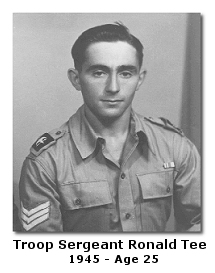Tee, Ronald A.
- Date of birth:
- December 1st, 1919 (Portsmouth, England)
- Nationality:
- British
Biography
Ronald Arthur Tee is born in Portsmouth, England and as a small boy, he moves with his parents and three brothers to Pinner, a small town in the Greater London area.
At the age of twenty, he is drafted into the Army. On February 15th, 1940, he is enlisted in Guilfdford where he serves with the Queen's Royal Regiment. After completing his infantry training in West Surrey, he is transfered to Newcastle. On January 22nd, 1941 he volunteers for the Reconnaissance Corps (which became part of the Royal Armoured Corps later on) and becomes a member of 56 Reconnaissance Batallion (later Regiment). He would stay with this unit until the end of the war. Ron Tee is incorporated in 16 Troop C Squadron under command of Major Jack Forshaw.
October 1942, he is sent overseas and comes ashore in Algiers. His first encounter with the enemy is in November 1942 near Djebel Abiod in the Tunisian campaign. He stays in Tunisia for six months and subsequently takes part in the invasion of Sicily. The presence in Sicily lasted some 3 to 4 four weeks but losses were high.
After Sicily he is taken by boat to the eastern coast of Italy in support of the Canadians near the river Sangro. Advance in Italy is slow because the landscape favours the defenders. On numerous occasions, Tee has to do the job of the infantry to fight and hold the defensive line. A tedious advance along the east coast of Italy takes him from Foggia and Lucera to Termoli where they are finally relieved.
From there they are sent further inland, reaching the small mountain village of Vastogirardi on December 31st, 1943, where they get bogged down by a fierce snow storm. At the end of three weeks they are relieved by a mountain corps of American and Canadian ski troops and advance further inland. In February 1944, Ron Tee gets involved in the battle for Monte Cassino where he sees action three times; twice to defend the front line while other units launch an attack, the third time, together with his 78th Division, he takes part in a frontal attack by the British Army and the Poles. This time they bypass the monastery and cross the Rapido River. This was a costly move, as far as casualties were concerned but it was successfull. When the Poles enter the monastery, the Germans have long gone, leaving behind only a few casualties. The remainder of the Germans had withdrawn across Highway 6 to Rome. Monte Cassino is ultimately captured.
In a village south of Rome, Ron Tee is injured in a minor accident caused by himself. As a result he is forced to stay in hospital for several weeks to recuperate.
In the fall of 1944, conditions in the mountains deteriorate, slowing them down in mud. In December he is granted a month's leave and back home in England, celebrates Christmas and New Year's Eve, he returns to the front however with a heavy heart because hardly any progress has been made there.
After the dropping of leaflets, urging them to surrender, many Germans prefer to do so to mainly British units. Finally, they cross the Po River, meeting little resistance from the Germans. In early May, advancing further into northern Italy, into the Italian Alps, they receive an unexpected radio message to the effect that a cease-fire has been declared. When they reach Austria, the war is over.
On May 8th, 1945, Ronald Arthur Tee is awarded the Italy Star and also receives the Five Services Chevrons. On September 11th, 1946, he gets an honourable discharge from the British Army. In 1953, he emigrates to Canada with his wife and children to start a new life.
Do you have more information about this person? Inform us!
- Period:
- Second World War (1939-1945)
- Rank:
- Lance-Sergeant
- Unit:
- 16 Troop, C Squadron, 56th Reconnaissance Regiment, 78th Infantry Division, British Army
- Awarded on:
- March 19th, 1944
- Period:
- Second World War (1939-1945)
- Rank:
- Troop Sergeant
- Unit:
- 16 Troop, C Squadron, 56th Reconnaissance Regiment, 78th Infantry Division, British Army
- Awarded on:
- May 8th, 1945




